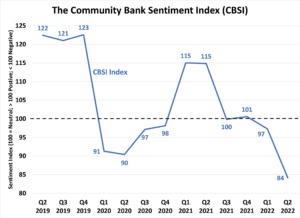Community banker views of future business conditions plummeted in the second quarter due to concerns over monetary policy, business conditions and regulations, according to the Conference of State Bank Supervisors’ quarterly Community Bank Sentiment Index.

The index fell 13 points to 84, its lowest reading since the readings began in 2019. Any reading above 100 indicates positive sentiments with any number below signaling negative feelings. Bankers were especially wary of how the Federal Reserve’s monetary policy decisions will impact market conditions: Those sentiments dropped 62 points from 95 in the first quarter to 33 in the second. As reported by the Associated Press, Federal Reserve officials in June expressed concern that consumers were expecting higher inflation, and they signaled that much higher interest rates could be required to tame decades-high inflationary readings. Though the policymakers said rate hikes could weaken the economy, they also suggested that doing so was necessary to slow price increases back to the Federal Reserve’s annual 2 percent target.
Bankers were also far more pessimistic over future business conditions in the second quarter, with sentiments falling 45 points from 83 in the first quarter to 38 in quarter two. The regulatory burden component fell by 9 points from the previous quarter to a record low of 19.
“Community bankers are mostly concerned about rising inflation, particularly energy and commodity prices, the impact of rapid interest rate increases and slower economic growth,” said CSBS Chief Economist Tom Siems.
Community bankers had a positive view of profitability. The reading rose 33 points from 68 in the first quarter to 101, the first time that has eclipsed 100 in a year.
U.S. community bank earnings in aggregate are expected to dip 1 percent this year due to higher credit costs and lower fee income reducing the benefit of NIM expansion, according to an S&P Global report. Earnings are unlikely to grow either this year or in 2023 as credit costs normalize and fee income drops, “A rising rate environment and sustained economic recovery from the pandemic will create a more favorable operating environment for community banks, but earnings growth could be hard to come by in the near term,” S&P Global stated.
